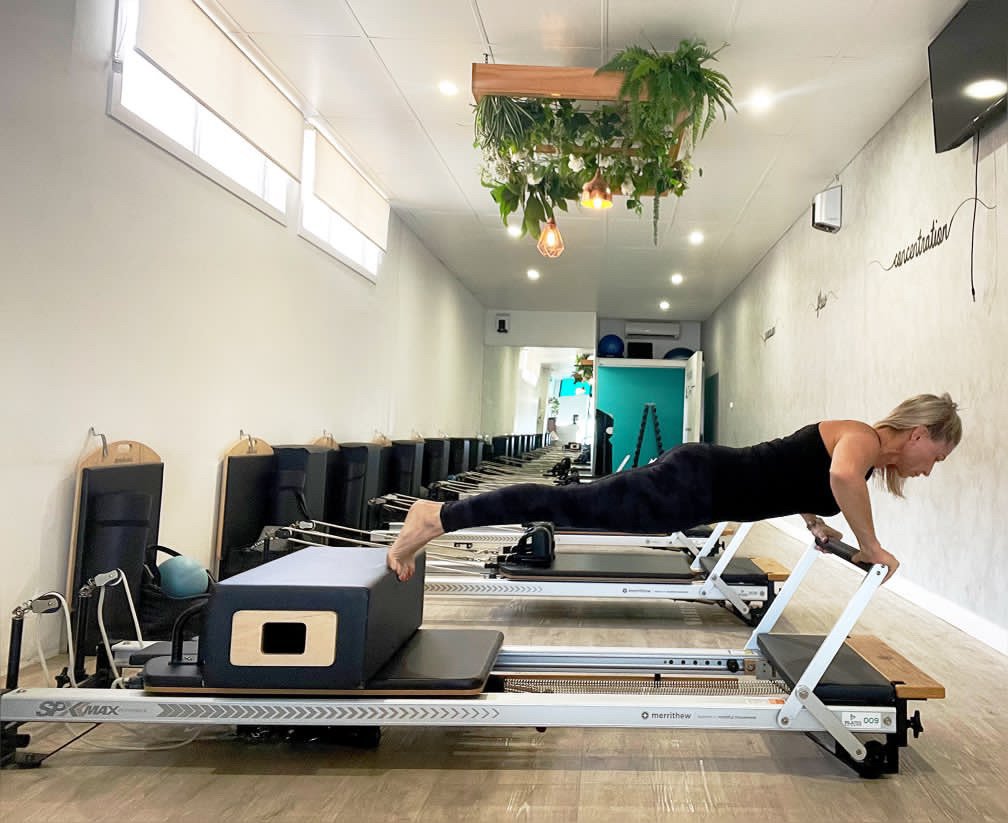Progressive Push-Ups on the Reformer: Build Strength and Control
Progressing to a full push-up takes time, dedication and practice. So naturally it’s not for the faint-hearted. Nor is it for every client. Maybe it’s something you want to work on for your self-practice.
In this article, we go through the various progressions of a push-up so you understand where you can take your practice as a Pilates professional.
----------------------------------------------------------
To be able to complete a full push-up, on your toes, you will need a strong core, back, chest, arms and shoulders and leg strength as push-ups are a full body integrated movement, meaning several of your muscles are working together at once.
If you cannot complete a push-up on the toes then you may want to start with strength-building exercises like maintaining a plank. Start on the knees if needed and then build to the toes. Progress the time held in the plank until you feel you can layer in ‘progressions’ like alternate shoulder taps or a single-leg plank. Increase the time held in these progressive moves and once you can complete these different variations with good form and technique, it's time to start to attempt a push-up on the Reformer.
Again, start your push-up by stacking on the knees first and then build to the toes. Progressing the number of repetitions you can complete your push-ups in each variation.
If you find this increasingly difficult, there’s always a regression you can start with. Things like building your arm strength with bicep and or tricep exercises or building your back strength first if required before starting your Plank.
Start on a light spring.
Before we begin, make sure you know your limitations before starting. I would suggest starting off with a medium spring first and then progressing to a lighter one over time. Using a medium and light spring will give more support to your core and back if this is your first time completing a push-up - so it makes for a safer option for keeping the carriage fairly still. That being said it will also be stronger on the shoulders/ arms so have this in mind and know your limitations. I recommend ‘at least’ starting off with a medium spring to start with and see what works best for you from here.
The lighter the spring the harder your work will be on maintaining trunk and core stability for your move so this will be your goal to progress.
1- Start on the knees with feet/ legs up against the short box and arms out wide on the footbar. Essentially you are in a kneeling plank position so trunk in a diagonal position. Commence your push and then pull the knees in towards the footbar, (or think knee tuck) and press the knees back out so you are back in your kneeling plank set-up position and go again.
2- Both feet against the short box and commence the push-up again by pulling the chest towards the footbar and then pushing the chest away, keeping the whole body strong and spine neutral. Pull the knees in and out and go again.
3- Staggered leg - one foot is on the high edge of the short box and one foot is low on the bed (carriage) against the short box- again complete your push-up by pulling your chest towards the footbar and pushing away again. Keeping stillness through your trunk and carriage WHILST maintaining neutral placement of your hips so your hips stay nice and square through the movement. Pull the knees in towards the footbar and then press the legs away and complete the movement again.
4- Repeat other side. Make sure you even up!
5- Both feet/ toes are now against the high edge of the short box- complete for your full-range push-up by pulling arms out wide and chest to the footbar. This is starting to get quite a bit harder now so watching your range is crucial and sometimes even changing the spring load up by just a quarter will benefit your core and back. Watch the hips do not sink or the low back collapse. Bend both knees in and go again.
6- Now, it's time for the grand finale move. One foot against the high edge of the short box and the other leg in a static leg raise hold. Complete your push up- pull the single leg on the box in and out and whilst keeping your leg raised and extending back through the hip and level. Lower your leg raise down to the box and then repeat the other side.
Important things to keep in mind:
In all steps of a progression your hands remain on the footbar. You could try the platform extender so you are in a decline position, however this set-up would be much harder.
- Shoulders must be positioned over hands throughout all the moves.
- Maintain a long, stacked and neutral spine throughout.
- Always activate and engage your core/ lifting your pelvic floor BEFORE you commence your push-up.
- Breath is crucial to help you move. Breathe in to lower and breathe out to push-up.
- Elbows wide, strong shoulders and strong legs - everything is working here.
Always check in on these considerations with each move and if you slump through the shoulders or lower back then maybe take it back to the previous step and go again.
And remember progress is progress. We’ve all got to start somewhere!
Kylie is the owner of Pilates on Point in the Gold Coast, Queensland Australia and features regularly on Dynamic Pilates TV. You can find online POP classes here.






